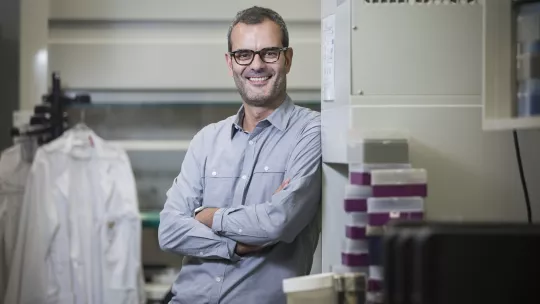Images
Researchers at IRB Barcelona reveal a communication pathway between the biological clock of organs and tissues that is independent of regulation by the central nervous system.
Alterations of the circadian rhythm are associated with premature ageing.
The work has been published in the journal Science Advances.
The biological clock/circadian rhythm is the mechanism that ensures that a certain physiological process takes place at a specific time of the day or night. It is coordinated by the brain at a general level, but each organ or tissue is also subjected to specific regulation. Adjusting to geophysical time is a way to optimise processes, but how does the liver “know” when it is day or night?
Scientists led by ICREA researcher Dr. Salvador Aznar-Benitah at IRB Barcelona have discovered how skeletal muscle regulates liver function and determines fat metabolism. Specifically, a molecule secreted by muscle and that reaches the liver through serum is responsible for modulating around 35% of the metabolic functions of the liver. The remaining basal functions of this organ and others related to carbohydrate metabolism are independent of muscle activity and are regulated by the basal circadian rhythm, that is to say, by the brain.
“It’s a very nice discovery because it is the first demonstration of the need for communication between the circadian clocks of tissues and organs outside the brain, and we can see that this communication between muscle and liver is altered by ageing,” says Dr. Aznar-Benitah. “When we get older, cells stop obeying the biological clock and begin to perform functions in a non-optimal manner, leading to errors that cause tissues to age.”
This work has been a collaboration with the laboratories headed by Dr. Paolo Sassone-Corsi, at the University of California, Irvine (US), Dr. Pura Muñoz-Cánoves, at the Pompeu Fabra University (Spain), and Dr. Kenneth A. Dyar, at the Helmholtz Zentrum München (Germany).
The liver, conductor of sugar and fat metabolism
The liver’s main role is to help the body digest food, mainly fats and sugars. The brain is the main consumer of sugar in our body while skeletal muscle, which allows us to move, run and jump and also allows the heart to pump, is the main consumer of fat.
The mechanism published by the scientists in the journal Science Advances reveals that the liver is not autonomous in the metabolism of fats and that it is muscle that sends the message that it is time to switch on fatty acid metabolism and how it should go about this. “We didn’t expect to find this connection between the liver and muscle because it wasn’t known previously, but, on second thought, it makes complete sense that fat management is coordinated by one of its main consumers,” says Dr. Aznar-Benitah. Carbohydrate metabolism is dependent on the basal coordination exercised by the brain.
Circadian rhythm and ageing
Between 2011 and 2019, the Stem Cells and Cancer lab headed by Dr. Aznar-Benitah published several studies that explained how, with age, the circadian rhythm is altered and no longer focuses on matching processes with the day/night cycle to optimise results but rather on damage repair. This change leads to the “neglect” of physiological processes and causes the accelerated ageing of tissues and organs.
The authors also showed that the circadian rhythm is best preserved on a low-calorie diet.
Reference article:
Integration of Feeding Behaviour by the Liver Circadian Clock Reveals Network Dependency of Metabolic Rhythms
Carolina M. Greco, Kevin B. Koronowski, Jacob G. Smith, Jiejun Shi, Paolo Kunderfranco, Roberta Carriero, Siwei Chen, Muntaha Samad, Patrick-Simon Welz, Valentina M. Zinna, Thomas Mortimer, Sung Kook Chun, Kohei Shimaji, Tomoki Sato, Paul Petrus, Arun Kumar, Mireia Vaca-Dempere, Oleg Deryagian, Cassandra Van, José Manuel Monroy Kuhn, Dominik Lutter, Marcus M. Seldin, Selma Masri, Wei Li, Pierre Baldi, Kenneth A. Dyar, Pura Muñoz-Cánoves, Salvador Aznar Benitah* and Paolo Sassone-Corsi* (*co-corresponding authors)
Science Advancces (2021) DOI: 10.1126/sciadv.abi7828
About IRB Barcelona
The Institute for Research in Biomedicine (IRB Barcelona) pursues a society free of disease. To this end, it conducts multidisciplinary research of excellence to cure cancer and other diseases linked to ageing. It establishes technology transfer agreements with the pharmaceutical industry and major hospitals to bring research results closer to society, and organises a range of science outreach activities to engage the public in an open dialogue. IRB Barcelona is an international centre that hosts 400 researchers and more than 30 nationalities. Recognised as a Severo Ochoa Centre of Excellence since 2011, IRB Barcelona is a CERCA centre and member of the Barcelona Institute of Science and Technology (BIST).








